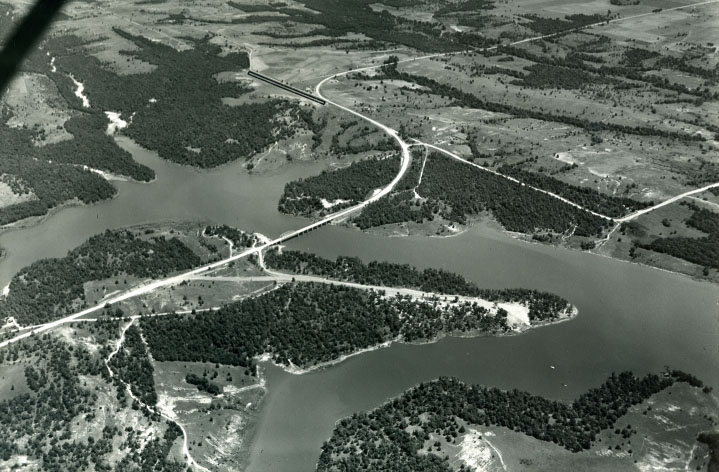
The History of Lake Texoma: From the Red River to a Recreation Powerhouse
Lake Texoma is more than just a scenic backdrop for RV getaways — it’s a living piece of American engineering, regional ecology, and human history. From its origins in flood control to becoming one of the Southwest’s most-loved recreation spots, the story of Lake Texoma is one of transformation and renewal.
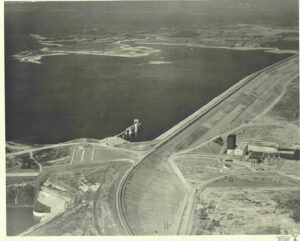
1. The Vision & Authorization – History of Lake Texoma
The idea for Lake Texoma began with a broader push in the 1930s to tame the Red River and address recurring floods that affected surrounding communities. Through federal legislation, funding, and engineering, what started as a civil works project would eventually reshape the region.
- The Flood Control Act of 1938 officially authorized the construction of Denison Dam and its reservoir, which would become Lake Texoma (source).
- The U.S. Army Corps of Engineers was tasked with designing and building the dam, with multiple purposes in mind: flood control, power generation, water supply, and later recreation (source).
2. Construction & Early Operation
Turning the plan into reality involved large-scale engineering, labor, and logistics — all against the backdrop of an America mobilizing for World War II.
- Construction began in August 1939, with completion in February 1944 (source).
- The dam was, at that time, the largest rolled-earth fill dam in the United States (source).
- The first hydroelectric turbine went online in March 1945, and a second unit in September 1949 (source).
- Initially, recreation was not among the project’s formal purposes — that designation came later in 1988 (source).
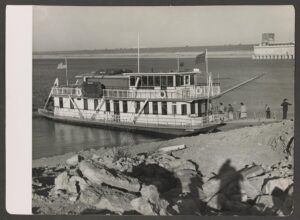
3. Geography, Capacity & Hydrology | Lake Texoma History
Once filled, the lake introduced new hydrologic and geographic dynamics to the Red and Washita Rivers.
- Lake Texoma straddles the Texas–Oklahoma border, touching Bryan County, OK and Grayson County, TX (source).
- It covers roughly 74,686 acres at full pool (source).
- The lake’s water level typically lies between 615–619 feet elevation (msl) (source).
- In major flood years, Texoma has topped the spillway, reaching 645.72 ft in 2015 (source).
4. Human Impact: Towns, Relocations & Lost Land
Forming such a massive reservoir meant major changes to pre-existing land and communities.
- Several small towns — including Aylesworth and Woodville in Oklahoma — were submerged when the lake filled (source).
- On the Texas side, communities like Hagerman and Preston were also displaced (source).
- Important archaeological and Indigenous sites were likely lost beneath the rising water (source).
5. Growth of Recreation & Era of Segregation
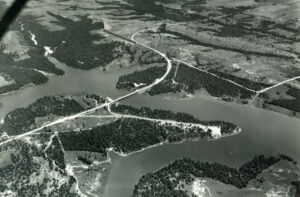
Though recreation wasn’t an original purpose, it quickly became one of the lake’s defining roles — even through challenging social eras.
- In the mid-20th century, Lake Texoma became one of the region’s first major recreation zones (source).
- During the Jim Crow era, recreational access was racially segregated (source).
6. Modern Era — Visitor Magnet & Landmark
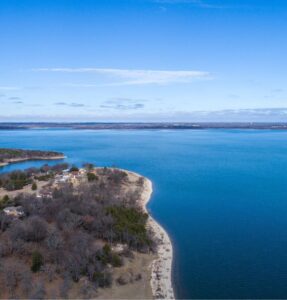
Lake Texoma is now a core regional landmark for both recreation and resource management.
- It’s the largest lake by capacity in the Tulsa District and the 12th-largest U.S. Corps lake (source).
- Nearly 6 million people visit annually, making it one of the most-visited U.S. Corps lakes (source).
- The lake’s shoreline supports parks, marinas, RV resorts, and wildlife areas (source).
- In 2015, historic flooding created a massive whirlpool above the spillway that went viral across national news (source).
7. Why the History Matters for Sunset View RV Resort
Understanding Lake Texoma’s history adds meaning to every stay at Sunset View RV Resort in Kingston, Oklahoma.
You’re camping beside one of the most significant hydro-engineering projects in U.S. history — a lake that turned two states’ floodplains into a haven for outdoor recreation, wildlife, and community.
Visit Sunset View RV Resort to experience lakeside RV living where history and recreation meet.
